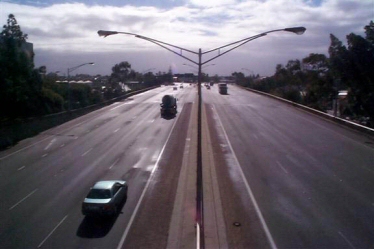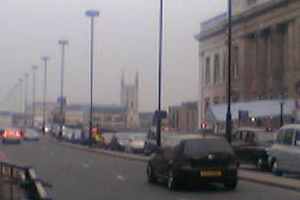Effects of the automobile on societies
|
|
Over the course of the 20th century, the automobile rapidly developed from an expensive technological wonder into the de facto standard for personal transport. The development of the automobile built upon the transport revolution started by railways, and like the railways, introduced sweeping changes in infrastructure, manufacturing and legislation.
| Contents |
Economic changes
The development of the automobile has caused changes in city planning, as well as changing the roles of horses and railroads.
Industry restructuring
Huge industries devoted only to the automobile were created. Others were expanded from once trivial insignificance to imminent importance. Before the internal-combustion engine was developed, gasoline was a waste product, often discarded. Once the automobile became commonplace, the production of gasoline blossomed into a matter of such importance that the governments took action to secure a steady flow of oil. The steel industry was already established, but the coming of the automobile created huge amounts of business for it. The chemical, rubber, and petroleum industries were remade to suit the needs of the automobile and industries sprang up, such as service stations, motels, and automobile insurance, that were completely reliant upon the automobile for their livelihood.
Infrastructure
Aside from industries, one of the most visible effects the automobile has had on the world is the huge increase in the amount of surfaced roads. For example, between 1921 and 1941, the United States spent US$40 billion on roads, increasing the amount of surfaced road from 387,000 miles (619,000 kilometres) to over 1,000,000 miles (1.6 million kilometres).
With increased road-building came loss of habitat for wildlife on a massive scale. Loss of rural areas and agricultural land to pavement has also been extensive.
The quality of roads was also improved. Roads were paved with asphalt, (an environmental hazard) and roads with more than one lane on each side became commonplace.
Technological Changes
Production
The assembly line and other methods of mass production were developed when American businessmen began seeking ways to build more automobiles at a lower price. The idea of using many small identical parts that could be exchanged for each other was engendered by the president of the Cadillac Automobile Company, Henry M. Leland. Once other automobile makers realized the value of small identical parts that were interchangeable, they hired many small machine shops to make identical parts that were then put together at assembly plants. Because of this, broken parts could easily be sent to car owners. This greatly prolonged the life of the automobile, making it even more attractive to consumers.
Ransom E. Olds took the first step towards assembly line production when had the framework of each automobile pushed on a wooden platform supported by rolling casters. Henry Ford built on this when he used conveyor belts to pull along the bare frame of a automobile while workmen added parts to it that were brought to them by other conveyor belts. Ford's utilization of the conveyor belt in the factory was inspired by the Chicago Packing Association's disassembly line, where workers dressed beef pulled along by an overhead trolley.
Cultural changes
Prior to the appearance of the automobile, horses, streetcars and bicycles were the major modes of transportation within cities. Horses require a large amount of care, and were therefore kept in public facilities that were usually far from residences. The manure they left on the streets also created a sanitation problem. The automobile had neither of those disadvantages.
The automobile made regular medium-distance travel more convenient and affordable, also in areas without railways. Because automobiles did not require rest, and were faster than horse-drawn conveyances, people were routinely able to travel farther than in earlier times. Historically, most people never travelled more than a few tens of kilometres of their birthplace in their entire lives; the advent of the automobile began the transformation of society in such a way that those who had never travelled that distance were only a tiny minority.
Changes to urban society
Beginning in the 1940s, most urban environments in United States lost their streetcars, Cable cars, and other forms of light rail, to be replaced by diesel-burning motor coaches or buses. Many of these have never returned, though some urban communities eventually installed subways.
Another change brought about by the automobile is that modern urban pedestrians must be more alert than their ancestors. In the past one had to worry about being run over by streetcars, kicked in the face by horses, or stepping in horse dung. Now, one must worry about being hit by automobiles at much higher speeds, and breathing noxious exhaust fumes. The Futurama exhibit at the 1939 New York World's Fair showed a City of the Future in which pedestrian and automobile traffic was fully grade-separated. However, for cost reasons, this vision has never come to pass outside of small experiments in a handful of downtowns. See skyway.
The loss of pedestrian-scale villages caused a loss of community connection. People no longer know their neighbors and rarely walk unless they place a high value on exercise.
Also, in countries with high levels of violent crime like the United States, most people who exercise prefer to do so in the safety of their home or in subscriber-only fitness clubs (which they drive to and from).
Advent of suburban society
Because of the automobile, the outward growth of cities accelerated, and suburbs began developing rapidly for the first time. Until the advent of the automobile, factory workers were forced to live close to the factory or a railroad line that led to the factory. The automobile allowed them to live miles away from the stench and grime of the factories and the city, yet still work at a factory. The developing suburbs created few local jobs, forcing residents to commute elsewhere to their jobs.
Shopping centers were then built in or near suburbs to save residents trips to the city. The shopping centers provided enough goods and services to reduce the need of suburban residents to visit the city.
Recreation
The creation of good roads and dependable automobiles changed recreation and vacations. Before the automobile, resorts were predominantly found near the coast or a railroad. If people did not live near either one, then they were unlikely to be able to visit one. Once the automobile became abundant, resorts sprang up that were off the beaten path. Resorts appeared in scenic places, far away from the hectic life of the cities. In the United States, national parks became popular tourist attractions and developed designs with automobile travelers in mind.
Social status
The automobile rapidly became a symbol of social status, and in some cases, a fashion item. The automobile, more than almost any other possession, allowed people to flaunt wealth. Not only was (and is) the ownership of an automobile demonstrative of a certain level of income and prestige, it is also highly visible.
Safety
Automobile accidents caused many deaths before automobile safety laws were implemented. To this date, automobiles remain a major cause of accidental death and injury, not to mention emotional stress.
Drivers of automobiles are able to move relatively quickly in and out of inner-city urban cores. In comparison to pedestrians or users of mass transit, they are slightly less vulnerable to mugging, but are naturally vulnerable to crimes like carjacking, to torts like injuries sustained in car accidents, and to the inconvenience of vehicle breakdowns.
The automobile expanded the role, abilities and efficiency of the emergency services such as the response to a emergency calls for firefighters or paramedics.
Car-oriented convenience
Many aspects of daily life in the First World industrialized countries reflect an impulse to make life convenient for car users.
Without having to exit one's car, a resident of a typical large North American city may accomplish the following:
- Buy gasoline at a gas station (in areas where full service is still available)
- Have the car washed
- Obtain cash from an ATM
- Buy many different kinds of fast food, and eat it
- Buy freshly prepared coffee or other such highly specialized beverages
- Deposit mail for delivery by the postal service
- Drop off apparel for dry cleaning
- Return library books, videotapes, or almost any other small object that is regularly lent to the public
Environmental Changes
The automobile is one of the most destructive modern influences on the environment. For a large part of its development, no consideration was given to concerns such as air pollution, destruction caused by road-building, and the massively increased consumption of limited natural resources, most notably petroleum. Some of these concerns are now starting to be addressed in some parts of the world.
Related topics
- the carfree movement
- car addiction
- carbon economy
- congestion
- economic growth
- employment
- external costs
- freedom
- mobility
- obesity
- oil dependency
- pollution
- positive feedback, aka non-linear development (virtuous cycles and vicious cycles)
- safety
- segregation
- social exclusion
- social mobility
- social status
- speed
- stress
- systemics
- urban sprawl
- waste


